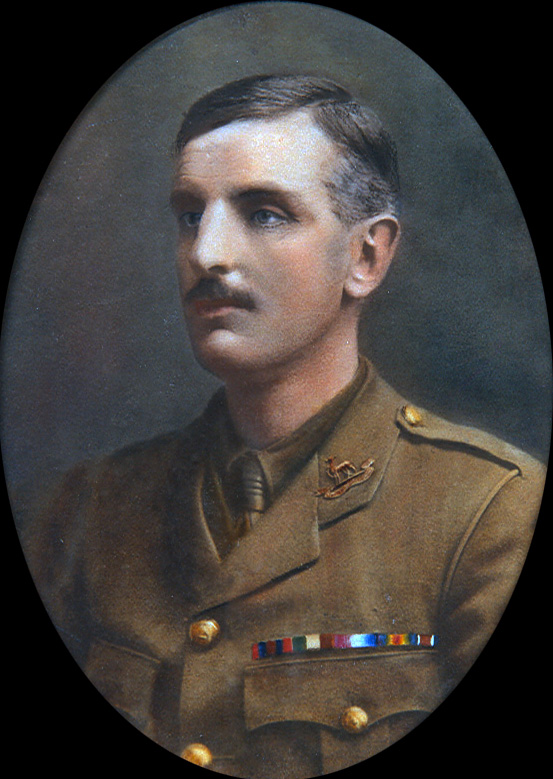Over the Christmas period in 1914, fraternization took place in No Man’s Land between British and German soldiers at St. Yvon in Belgium. Memorials in the Belgian villages of St. Yvon and Messines commemorate a football game played between the British and the Germans during the Truce. Whenever this author mentions that his grandfather Robert Hamilton, a captain in the 1st Battalion of the British Army’s Royal Warwickshire Regiment, was involved in the Christmas Truce at St. Yvon, he is invariably asked whether Hamilton played in a game of football against the Germans.
It is a fair question given that it is now widely accepted that there was an ‘international’ match there. However, evidence from accounts by those who took part in the Truce casts doubt over whether such a game took place at all and calls into question the justification for the installation of the three memorials, one on the edge of Ploegsteert Wood and two in Messines.
Where Did the Story Come From?
One of the most compelling accounts of the Christmas Truce and the warfare that preceded it, is to be found in Hamilton’s diary which he kept throughout his five months on the Western Front. It offers a graphic and harrowing account of mobile fighting before the onset of attritional trench warfare.
He vividly described the rain, mud, dangers and discomforts of life in the trenches and the daily fight for survival against shelling and sniping. His descriptions of life behind the lines, billets, estaminets and local hospitality are detailed and perceptive. His record of the humor and comradeship of his fellow soldiers is also heartwarming and entertaining.
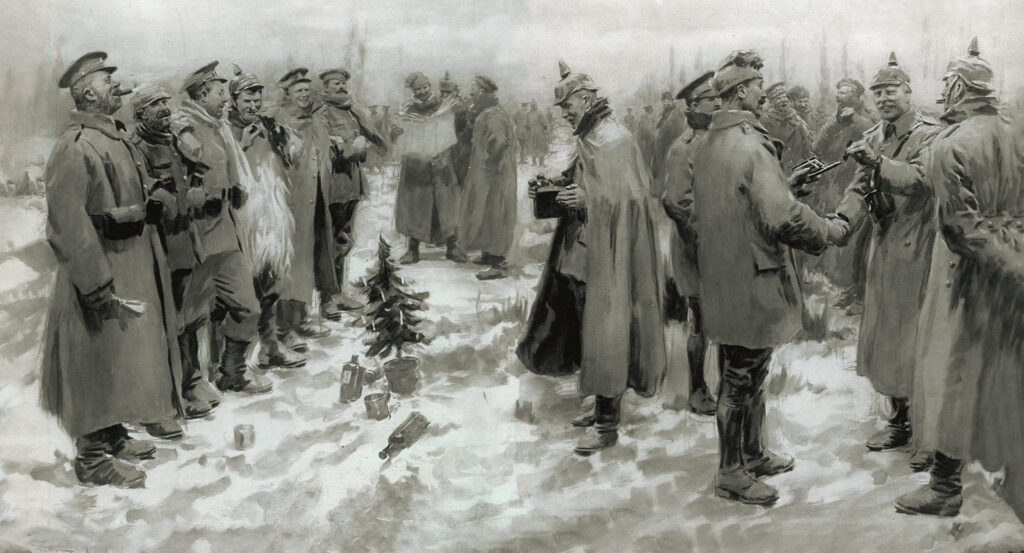
At the war’s outbreak in 1914, Hamilton was 37 years old. He had been brought up in Tiddington, a village near Shakespeare’s Stratford-on-Avon in Warwickshire, England and was educated at Glenalmond College in Scotland, after which he became a regular in the British Army. He joined the Norfolk Regiment with whom he fought as a 2nd lieutenant in the Boer War 1899-1902.
By 1914 he had been transferred to the 1st Battalion of the Royal Warwickshire Regiment, whose men were commonly known as the Royal Warwicks. It is clear from his diary entries that he was a good friend of Bernard Law Montgomery, the future Field Marshal and architect of notable victories over Germany in World War II. On Aug. 8, 1914, Hamilton recorded when at Shorncliffe in Kent waiting to cross the Channel to France that, “Bernard and I walked down to get our valises, which they refused to let us fetch. This was the first major piece of red tape rot, which Bernard and I quite made up our minds must cease.”
Thirty-mile marches and ducking German shells exacted a toll on the Royal Warwicks. Hamilton complained on Sept. 12 that, “This is the hell,” and on Sept. 19 that, “I am sure I look fifty, I feel seventy.” Hamilton was promoted to the rank of captain after his superior, Charles Bentley, was court martialled for constant drunkenness, much to his and Montgomery’s relief.
On Oct. 13, 1914, in one of their first major actions of the war, the Royal Warwicks fought in the battle of Meteren, losing 42 men killed and 85 wounded. The battle ended Montgomery’s front line action when he was hit in the lung and knee. He was hospitalized in St. Omer and returned to Southampton, England via Boulogne on Oct. 18 to recover.
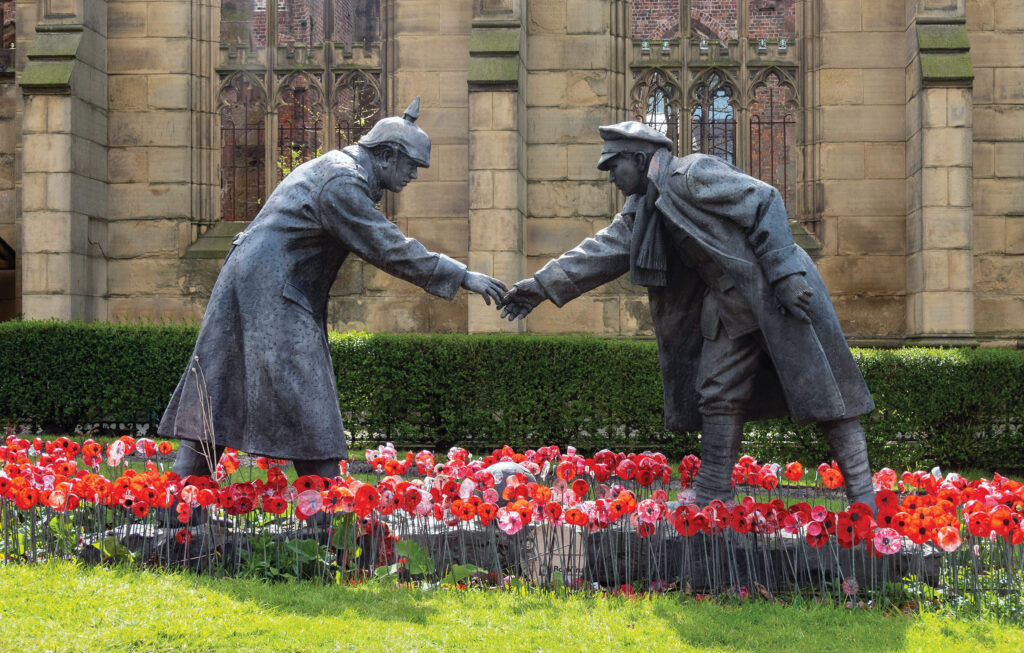
Prior to the Christmas Truce, Hamilton and the Royal Warwicks were based in trenches on the edge of Ploegsteert Wood which on Nov. 22 were, he wrote, “in a shocking way. Dead bodies everywhere and the stink awful.” On Dec. 11, he wrote: “It rained all night and the whole of today. When I went round the sentries, I found them quite resigned to another flood. They were amused. One Private Carter said “it will lay the dust, sir, won’t it?” at which I laughed heartily and so did they. But poor fellows were on their last legs for this trench trip.”
Christmas at St. Yvon
In November, Hamilton had been delighted that Bruce Bairnsfather, a family friend from prewar days in Stratford-on-Avon, had arrived at the front. Bairnsfather would become celebrated for his cartoons of life in the trenches published in The Bystander magazine, especially his British “Tommy” characters Alf, Bert and most famously “Old Bill.” Bairnsfather captured life in the trenches in an inimitable style—for example, a Tommy caught in the light of a German star shell having drunk a whole jar of rum, the meeting of a British and a German officer in No Man’s Land, and the spectacle of a Birmingham barber cutting the locks of a long-suffering private of the Royal Warwicks with the warning, “Keep yer ’ead still or I’ll have yer blinkin’ ear off.”
At 6.30 p.m. on Christmas Eve 1914, Hamilton’s A Company of the 1st Battalion Royal Warwicks set off from their billets at La Crèche in France to relieve the Royal Dublin Fusiliers in the trenches at St. Yvon over the border in Belgium. Over 100 years later, if one follows in their footsteps from the magnificent Ploegsteert Memorial along Mud Lane to Prowse Point Military Cemetery, one will find the memorial unveiled in December 2014 by French football star and administrator Michel Platini, which has since been swamped by football shirts and scarves and surrounded by footballs. Behind the original German front line at Messines the main football-inspired memorial is a replica of a memorial first unveiled in 2014 in Liverpool outside St. Luke’s Church.
A wealth of accounts of what happened over the Christmas period at St. Yvon shed a different light on what actually transpired there. These accounts include firsthand British reports by four officers including Hamilton, three NCOs, nine privates and an account by a German officer, Leutnant Kurt Zehmisch of the 134th Saxon Regiment.
Of the many truces that took place on the Western Front in 1914, this one is unquestionably the best documented. Using this material, it is possible to paint a comprehensive and detailed picture of what happened during the fraternisation in that sector of the Western Front—including about whether the legendary football match ever took place.
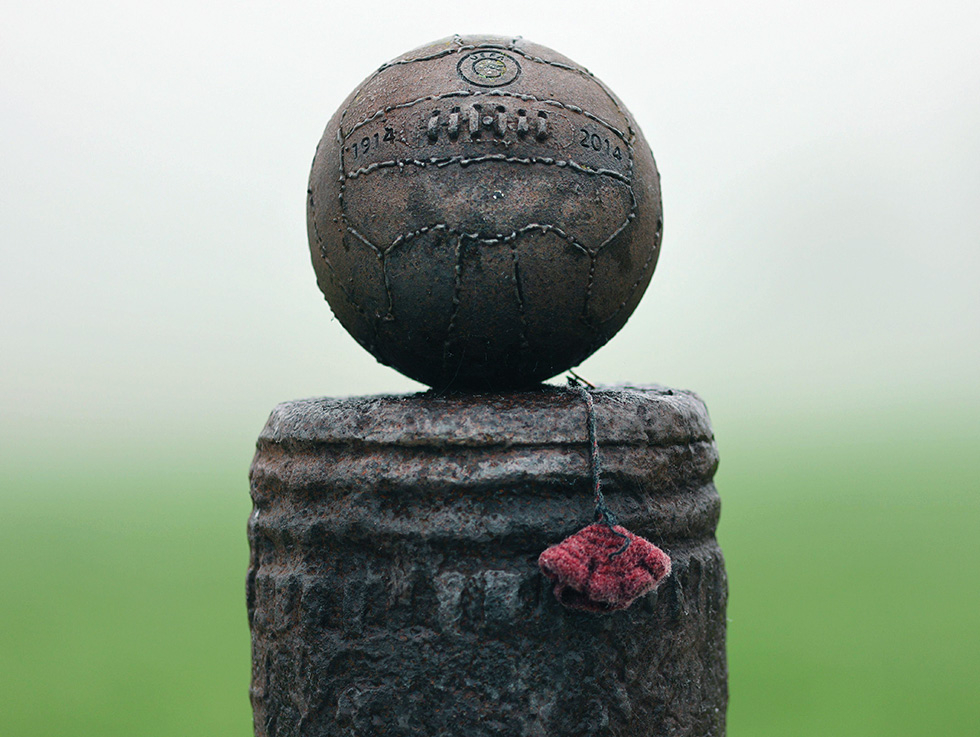
Most of the British soldiers who had been at the Front since August 1914 were “regulars”—professional soldiers—rather than the thousands of volunteers who answered Horatio Herbert, 1st Earl Kitchener’s call to arms. Assured the war would be “over by Christmas” they found themselves tired and homesick after four months of tough combat.
Unsurprisingly they were, according to Hamilton’s diary, “a little sad at spending Christmas Day” in the trenches when they set off for them at 6.30 p.m. When the men approached their trenches, it was clear something was amiss. Hamilton recalled that, “Crossing the well worn danger zone to our consternation not a shot was fired at us.’ After much shouting to and fro across No Man’s Land, Private Gregory, was given permission by Hamilton to go and parley with the Saxons “at your own risk”. On his return, he informed his officer that, “they [the Germans] wanted me to meet their officer and after a great deal of shouting across I said I would meet him at dawn, unarmed.”
Meeting the Germans
For the Royal Warwicks who had suffered several weeks of wind, rain, flooded trenches, shelling and sniping, the interaction with the 134th Saxons on Christmas Eve was extraordinary and unexpected. Carols were sung by both sides. Leutnant Zehmisch ordered Christmas trees to be lit with candles along the trenches.
Lt. Cave recalled that “they had their Christmas trees blazing all night” and Pvt. Day wrote that on Christmas Day at “about 1 o’clock they struck up with a band of concertinas and a cornet; they played ‘Home Sweet Home’ first, then a lot of other tunes finishing up with “God save the King.” Pvt. Charlie Pratt was in awe that “the Germans sent up a star shell which lit up the place lovely and then for the first time we saw friend and foe.” Pvt. Walter Cooke considered that “the band sounded great, much better than hearing shells whistle overhead” while Pvt. Langton recalled that “we would sing a carol first and they would sing one. I tell you they can harmonize alright.”
It was inevitable that fraternization would take place on Christmas morning. Hamilton wrote he “went out and found a Saxon officer of the 134th Saxon Corps, who was fully armed. I pointed to his revolver and pouch. He smiled and said, seeing I was unarmed, ‘Alright now.’ We shook hands, and said what we could in double Dutch, arranged a local armistice for 48 hours, and returned to our trenches. This was the signal for the respective soldiers to come out. As far as I can make out this effort of ours extended itself on either side for some considerable distance. The soldiers on both sides met in their hundreds and exchanged greetings and gifts. We buried many Germans, and they did the same to ours.”
In the evening a number of officers enjoyed a concert in ‘D’ Company’s dugout until midnight. It was, according to Hamilton, “a very merry Xmas and a most extraordinary one.” There was nonetheless a feeling that the enemy could not be trusted, so Hamilton “doubled the sentries after midnight.”
Exchanging gifts
Hundreds of soldiers swapped postcards, photos, pipes, mufflers, tobacco, cakes, buttons, tins of bully beef and cap badges. The most popular exchanges were, as Day noted “cigarettes for cigars, a gift from the Kaiser.” He also received “some of their postcards which they signed and addressed.” Pvt. Layton was impressed with the Germans’ language skills: “There were a good many amongst them who could speak broken English alright and they said ‘You make it no shoot, we make it no shoot.’” For William Tapp, it was “a strange sight, unbelievable that we were all mixed up together.”
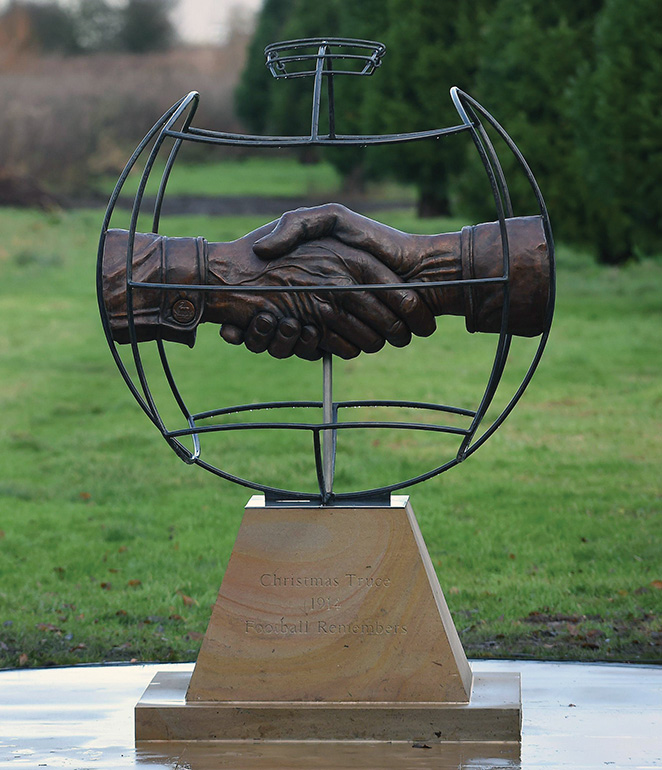
The armistice meant that an important job could be carried out. The Brigade War Diary recorded that ‘men of the Somerset Light Infantry, 134th Saxons, Hampshires, a Prussian and an Uhlan were all buried. The Germans helped in the digging with the 1st Battalion of the Royal Warwicks supplied the “tools” since the Germans stated they had none. Burial of the dead was a convenient excuse for the Brigade commanders to play down the enormity of what had happened.
At the time when British soldiers were fraternizing with the enemy in No Man’s Land, their superiors, Generals John French, Douglas Haig and Horace Smith-Dorrien were lunching in St. Omer. They were furious to hear reports of what had taken place. On Boxing Day, Smith-Dorrien sought details of officers and units who had taken part in the Christmas Truce “with a view to disciplinary action.”
Fraternizing with the Enemy
He wrote in his memorandum of Dec. 27: “This is only illustrative of the apathetic state we are gradually sinking in to… to finish this war quickly we must keep up the fighting spirit and do all we can to discourage friendly intercourse.” For the author of the 1/ Royal Warwicks War Diary, Christmas Eve was “a quiet day. Relieved the Royal Dublin Fusiliers in the trenches in the evening.”
There was no mention of what had taken place. The Brigade War Diary also played down the event and observed a positive opportunity for intelligence gathering: “A quiet day. No firing. The Germans appear to think that an armistice exists for Christmas Day. An informal interchange of courtesies took place between troops in the fire trenches of both belligerents. Some valuable information was gleaned during the intercourse. The trenches seem fairly strongly held, the enemy cheerful and well fed.”
Fraternizing with the enemy during a war was unacceptable and unheard of, so concerns about potential sanctions were expressed. Hamilton was told that “the General and staff are furious but powerless to stop it.” William Tapp feared the worst: “I don’t know what our General would say if he knew about this.” Pvt. Harry Morgan wondered that “if all the troops along the line had refused to fight on both sides, would the War have ended there and then?” In the event no one was reprimanded.
Hamilton returned home on leave in early January, recording in his diary on Jan. 12 that “All’s well that ends well.” He had suffered throughout the campaign with troublesome ears and visited an Army doctor in London who spared him further active combat. His diary then chronicles the “battles” he fought with Conscientious Objectors’ and “red tape” as Commandant of the Hereford Military Detention Barracks, a role he detested but which was arguably a small price to pay for avoiding further involvement on the Western Front and the huge losses suffered by the Royal Warwicks in April 1915 during the 2nd Battle of Ypres when the Germans used poisonous chlorine gas for the first time.
What About The Football?
So was a game of football played during this particular Christmas armistice? Although the many accounts contain numerous details about the truce, no evidence exists whatsoever to justify the creation of the three memorials to an “international” football match. Zehmisch wrote that “a couple of English brought a football out of their trench and a vigorous match began.” Pvt. Smith commented that the “Germans were interested spectators” of the kickabout. Zehmisch recorded that towards evening the English officers asked whether a big football match could be held on the following day, but he was unable to agree to a match as his company would be returning to their billets. Hamilton’s diary entry corroborates Zehmisch’s account: ‘’A’ Coy would have played the 134th Saxon Corps tomorrow only that the company was relieved.” Pvt. Walter Cooke was disappointed that “the Germans wanted to play at football but that fell through” and Tapp, a Birmingham City supporter, was upset that a game could not be arranged.
There can be no doubt that if a game of football had taken place, Bairnsfather would have captured the event in a cartoon with his characters Alf, Bert and ‘Old Bill’ flooring their opponents with crunching tackles, no doubt breaking legs and sending Saxon pickelhaubes flying to all parts of No Man’s Land. Bairnsfather limited himself to describing the football as just “a kickabout amongst the Royal Warwicks” (not with the Germans) and later in 1929 concluded in The American Magazine that “there had not been an atom of hate shown by either side. It was a punctuation mark on all the combatants’ lives of cold and humid hate.” A contemporary photograph of No Man’s land at St. Yvon shows it pitted with shell holes and extremely uneven—conditions hardly conducive for a football match.
For those who participated in the Truce at St. Yvon, it was a truly memorable event that would have been beyond their wildest dreams. Words that appear frequently in their accounts are “astounding,” “extraordinary,” “strange,” “unbelievable,” and “unique.” Morgan was impressed that “there were no guns, no bullets, no voices.” Zehmisch felt it had been “marvelous and strange” and his opposing officer Hamilton, admittedly resorting to hyperbole, started his diary entry for Christmas Day 1914: “A Day Unique in the World’s History.” For Tapp, “it was like a clock that had stopped ticking… it was very different to the other Christmas days I had spent, especially the one in 1910 when I stood under the mistletoe with the girl I later married.” Tapp was later killed during the German gas attack on April 25, 1915 and his name is, along with nearly 500 other Royal Warwicks with no known grave, recorded on the Menin Gate Memorial in Ypres.
Flimsy Evidence of a Match
The Truce at St. Yvon was similar to many held along as much as two thirds of the British-held trenches along the Western Front. This Christmastide there will be the usual references to games of football in the media and social media…but how many actually took place?
In the most comprehensive work on the Christmas Truce, Malcolm Brown and Shirley Seaton are skeptical about the numbers, stressing that the ground in No Man’s Land was too pockmarked and uneven for there to have been many matches. They do however assert that “there are a sufficient number of references to games which allegedly took place for it to be difficult to believe that this is all smoke without fire.”
Yet in most cases the evidence is flimsy to say the least. The most likely game to have taken place may have been across the border at Frelinghien in France where Leutnant Johannes Niemann of the 133rd Saxon regiment recorded that a soldier in the Scottish 2nd Battalion of the Argyll and Sutherland Highlanders produced a football and “now there developed a proper game of football with caps put down as goalposts. Quite a happening on that frozen field.” He concludes that “the game ended 3-2 to Fritz.” The Germans were much amused that the Scots were not wearing underpants beneath their kilts: “This delighted us hugely …” Unfortunately, Niemann’s evidence is not confirmed by any British accounts.
One thing we can be certain about is that a football match at St. Yvon is a myth and that the three memorials do no more than promote a legend. But at Christmas time why be Scrooge-like about this and let the truth get in the way of a marvelous story of peace and reconciliation—even if it was for only a day or two before the bitter war resumed in the New Year?

